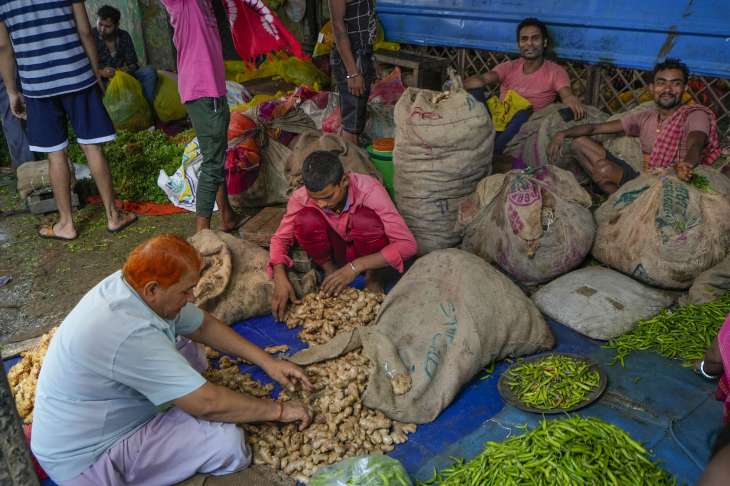Retail inflation rises to 3-month high in June on rising prices of kitchen essentials, factory output expands

Retail inflation rose to a three-month high in June on rising prices of kitchen essentials, while the factory output expanded at a faster pace of 5.2 per cent in May, according to the government data released on Wednesday. Retail inflation based on Consumer Price Index (CPI) increased to 4.81 per cent in June after declining for four months in a row but remained within the comfort zone of the Reserve Bank.
The Index of Industrial Production (IIP), which reflects the country’s factory output, rose to 5.2 per cent in May from 4.5 per cent in April 2023, mainly due to good performance by the manufacturing and mining sectors.
Both the data were released separately by the National Statistical Office (NSO), Ministry of Statistics and Programme Implementation (MoSPI).
The CPI-based inflation moved northwards after declining for four months since February. The RBI, which will be announcing its next set of bi-monthly monetary policy early next month, mainly factors in retail inflation while deciding the benchmark interest rate (repo).
Retail or CPI inflation stood at 4.31 per cent (revised upward from 4.25 per cent) in May and 7 per cent in June 2022. The previous high was recorded in March at 5.66 per cent.
According to the data released by the National Statistical Office (NSO), the inflation in the food basket was at 4.49 per cent in June, higher than 2.96 per cent in May. The food basket accounts for nearly half of the CPI.
The data revealed that the annual rate of price rise was 19.19 per cent in the case of spices, 12.71 per cent in ‘cereals and products’, 10.53 per cent in ‘pulses and products’, and 7 per cent in eggs. Fruits too were marginally costlier in June year-on-year.
However, there was a decline in inflation in ‘oil and fats’ (- 18.12 per cent) and vegetables (-0.93 per cent). The factory output growth measured in terms of the IIP stood at 19.7 per cent in May 2022, mainly due to a lower base effect.
“The growth rates over the corresponding period of the previous year are to be interpreted, considering the unusual circumstances on account of the COVID-19 pandemic since March 2020,” NSO said.
The manufacturing sector’s output grew 5.7 per cent in May 2023 against a 20.7 per cent expansion a year ago. Power generation rose 0.9 per cent in May 2023 compared to a growth of 23.5 per cent a year ago.
Mining output rose by 6.4 per cent during the month under review against an 11.2 per cent expansion in the year-ago period.
Commenting on the data, Icra Chief Economist, Head – Research and Outreach, Aditi Nayar said the spike in vegetable prices is set to push the CPI inflation to an uncomfortable 5.3-5.5 per cent in July 2023. “We expect the vegetable price shock to result in the Q2 FY2024 CPI inflation exceeding the (RBI’s) Monetary Policy Committee’s last forecast of 5.2 per cent.
“Accordingly, we anticipate that the Committee will retain its hawkish tone in August 2023, keep the repo rate unchanged and signal that a pivot to rate cuts remains distant,” she said.
National President of Commodity Participants Association of India (CPAI) Narinder Wadhwa opined that the rise in inflation suggests a potential change in the factors influencing consumer prices.
“It may be influenced by various factors, such as changes in demand-supply dynamics, fluctuations in global commodity prices, government policies, or other economic factors. The rise in inflation is higher than the street’s expectations,” he said.
The government has tasked the central bank to ensure retail inflation remains at 4 per cent with a margin of 2 per cent on either side. On IIP data, Nayar said the year-on-year performance of several high-frequency indicators related to freight and traffic movement deteriorated in June 2023 relative to May 2023, such as generation of GST e-way bills, cargo traffic at major ports, rail freight traffic, petrol and diesel sales, PV and 2W production as well as vehicle registrations.
“However, the year-on-year growth in electricity generation, output of Coal India Limited, and finished steel consumption improved in June 2023, relative to the previous month. Based on these trends, Icra expects the year-on-year IIP growth to moderate to about 3-4 per cent in June 2023,” she said. The NSO data further revealed that the capital goods segment grew 8.2 per cent in May this year compared to 53.3 per cent a year ago.
Consumer durables output during the month rose 1.1 per cent against a 59.1 per cent growth in the year-ago period.
Consumer non-durable goods output increased by 7.6 per cent compared to a growth of 1.4 per cent a year earlier. Infrastructure/construction goods posted a growth of 14 per cent over an 18.4 per cent expansion in the same period a year ago. The data also showed that the output of primary goods logged 3.5 per cent growth in the month against 17.8 per cent in the year-ago period. The intermediate goods output in May rose 1.6 per cent compared to a 17.5 per cent growth during the corresponding month last year.
(PTI)
Also Read: India imposes import restrictions on certain gold jewellery, articles due to THIS reason
Latest Business News
For all the latest Business News Click Here
For the latest news and updates, follow us on Google News.

